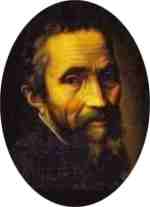The Cycles of History
| Leda | |
|---|---|
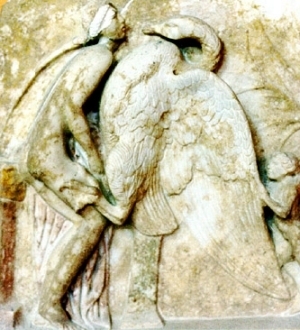
|
A sudden blow: the great wings beating still Above the staggering girl, her thighs caressed By the dark webs, her nape caught in his bill, He holds her helpless breast upon his breast. How can those terrified vague fingers push The feathered glory from her loosening thighs, And how can body, laid in that white rush, But feel the strange heart beating where it lies? A shudder in the loins engenders there The broken wall, the burning roof and tower And Agamemnon dead. Being so caught up, So mastered by the brute blood of the air, Did she put on his knowledge with his power Before the indifferent beak could let her drop? |
| Leda and the Swan, Herakleion Museum (photo: Barbara McManus) |
(AV A 179; AV B 267) draft title: "Annunciation" (Mem 272-74), "Leda and the Swan" (Mem 274-75, and all published versions except for A Vision) |
The Mother of God | The threefold terror of love; a fallen flare Through the hollow of an ear; Wings beating about the room; The terror of all terrors that I bore The Heavens in my womb. Had I not found content among the shows Every common woman knows, Chimney corner, garden walk, Or rocky cistern where we tread the clothes And gather all the talk? What is this flesh I purchased with my pains, This fallen star my milk sustains, This love that makes my heart’s blood stop Or strikes a sudden chill into my bones And bids my hair stand up? | 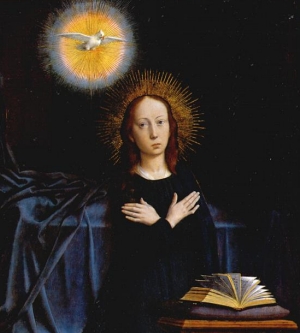 |
(VP 499) | Annunciation (detail) from the Cervera Altarpiece by Gerhard David (1460?-1523?), Metropolitan Museum |
General OutlineIntroductionThe Great YearThe Cycles of HistoryThe Millennial CycleFurther ComplicationsDove or SwanThe Future |  |
| The Historical Cones given by ‘Carmichael’, 10 December 1920 (YVP 3 61) |
General OutlineSince it affects the poetry more obviously and more directly than almost any other part of the System, the view of history proposed in A Vision has received more critical attention than any other area, not all of it entirely accurate. The basic principles are, however, relatively easy to grasp, and Yeats himself noted that the section treating history, ‘Dove or Swan’ (AV A Book III and AV B Book V), was among the more accessible parts of A Vision. The title ‘Dove or Swan’ alludes to a particularly potent yoking of ideas through symbol. The Archangel Gabriel’s annunciation to the Virgin Mary is often accompanied in art by a descending dove to symbolise the angel’s message that she would conceive a child: ‘The Holy Ghost shall come upon thee, and the power of the Highest shall overshadow thee: therefore also that holy thing which shall be born of thee shall be called the Son of God’ (Luke 1:35). The tradition of representing the Holy Ghost by a dove derives from the Gospel account of Jesus’ baptism: ‘And Jesus, when he was baptized, went up straightway out of the water: and, lo, the heavens were opened unto him, and he saw the Spirit of God descending like a dove, and lighting upon him: And lo a voice from heaven, saying, This is my beloved Son, in whom I am well pleased’ (Matthew 3:16-17). Yeats imaginatively contrasts the Annunciation to Mary and the divine conception, symbolised by the hovering dove, with an alternative annunciation: Leda’s rape by the god Zeus in the form of a swan, which led to the conception of Castor and Pollux, Helen of Troy and Clytemnestra. Yeats sets these two annunciations up against each other: in each one the bird symbolises the irrational and supernatural irruption of the divine into the human order, but one is a violent act which produces war and heroism, while the other is a gentle presence which harbingers peace and sacrifice. The Christian annunciation inaugurates a ‘primary dispensation looking beyond itself towards a transcendent power’, which ‘is dogmatic, levelling, unifying, feminine, humane, peace its means and end’; the preceding classical annunciation inaugurates ‘an antithetical dispensation’, which ‘obeys imminent [for immanent?] power, is expressive, hierarchical, multiple, masculine, harsh, surgical’ (AV B 263). The cyclical nature of Yeats’s conception means that there will be another antithetical annunciation in the near future, the second coming not of Christ but of His antithetical opposite, the focus of one of Yeats’s most celebrated poems ‘The Second Coming’ (see the Future).
Elsewhere, Yeats portrays the antithetical Messiah as Oedipus, ‘an image from Homer’s age’ (AV B 28), who lay down upon the earth and ‘sank down soul and body into the earth. I would have him balance Christ who, crucified standing up, went into the abstract sky soul and body’ (AV B 27):
This cycle, which he suggests here so speculatively, is of course the basis of his view of history. It is not, however, the only cycle involved, and its workings are slightly more involved than this outline indicates. 
IntroductionThe paradigm of the gyres and the cycles that they represent applies to every process, including the wider sweep of history. Like the harmonics of a plucked string, many different lengths of cycle co-exist within the overall cycle, each with its distinctive periodicity, so that at any one time each will be at its own stage of progress. Of particular importance within his treatment of the historical process are the cycles of roughly four thousand years, two thousand years and one thousand. An eight-thousand-year cycle exists but stretches too far back into pre-history to be useful, and the cycles of five hundred years and less begin to become too detailed for Yeats’s broad and impressionistic treatment. Yeats is not alone in discerning a cyclical pattern history, and such cycles are present in several ancient traditions, most notably Hinduism. In modern European tradition, Agrippa’s friend, the Abbot Trithemius, citing ancient precedent, expounded a cyclical series of epochs, governed by the seven planetary archangels, in ‘Concerning the Seven Secondary Intelligences’ (1508; another web-site gives the text), a scheme which was adopted in the twentieth century by Rudolf Steiner. A particularly influential scheme was proposed by Giambattista Vico in The New Science (1725; 3rd ed., 1744; see here for a translation), which starts from a scheme of development based on three ages attributed to ancient Egyptian doctrine. A more philosophical and abstract theory appears in G. W. F. Hegel’s Lectures on the Philosophy of World History (1822-1831) and The Philosophy of History (1837; another site’s text), and in the twentieth century the most widely known scheme is probably Oswald Spengler’s in Decline of the West (1918-1922; translated 1926-29; another site’s selections). Though Yeats did not know Spengler’s work when he published the first version of A Vision, he may have had an acquaintance with Vico’s and possibly with Hegel’s, and he studied them all in more depth as he prepared for the second edition, along with Flinders Petrie’s The Revolutions of Civilisation (1911), Hermann Schneider’s The History of World Civilization (translated 1931) and Henry Adams’ The Degradation of the Democratic Dogma (1919) (see AV B 261). More important and significant for him, however, was the astrological tradition of the ‘The Great Year of the Ancients’ (viz AV B Book IV, 243ff.), related to the phenomenon of the precession of the equinoxes, and it is this major cycle that determines the actual lengths of the periods involved. The Great YearThe length of the astronomical cycle of the precession of the equinoxes is calculated to be almost 25,786 years, or, as Yeats gives it, roughly 26,000 years (AV B 252 & 254). A twelve-fold division of this major period, produces a ‘month’ of 2,149 (25,786/12) or 2,167 (26,000/12) years, the fundamental unit of Yeats’s scheme (and the ‘Ages’ of the Great Year of conventional astrology, such as the ‘Age of Aquarius’). The situation is complicated slightly by the nonchalance of Yeats and his Instructors with regard to accuracy, so that the ancient calculation of 36,000 years sits alongside the modern one, giving months of 3,000 years, and, in the other direction, the period of 2,150 years is rounded to ‘two thousand and odd years’ (AV B 29) [note on numbers and precision]. The only clearly dated scheme, the diagram of the double cones that prefaces ‘Dove or Swan’ (AV B Book V, 267ff.), implies a period of 2,100 years (since the midpoint between 1 CE and the end of the cycle is given as 1050 CE) but the cycle does not move evenly, so it is not certain. It can be argued that such inaccuracy is a necessary fudging of the issue, without which Yeats’s numbers do not really work, but Yeats also makes it clear that even in the historical process there is the same slackening or speeding up of the greater cycle’s movement as in any other, and that the process of unfolding does not take place at a uniform pace: a given movement, trend or Zeitgeist will not be apparent in all places at the same time, arriving in one place earlier and in another later than the date given (see below). Precision in such matters would be a false exactitude, when the lag between places can be as much as five or six hundred years, and the shift from one constellation to another in the Great Year is impossible to specify. In the end, the reader must accept that Yeats was little bothered by precision, and preferred sweeping gesture to meticulous correlation. The ultimate benefit is the symbolic understanding which Yeats gained and which enabled such poems as ‘Leda and the Swan’, ‘The Statues’ or ‘Under Ben Bulben’, rather than giving the reader an infallible map of European history. The Cycles of History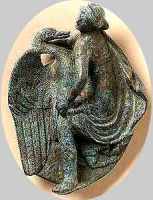
The most important cycles are:
Of subsidiary importance, but central to Yeats’s treatment of history in ‘Dove or Swan’, is:
Overarching the 2150-year, is a 4300-year cycle within which the periods of 2150 years are alternately antithetical and primary, and beyond these is the Great Year itself, within which there are seasons, including an antithetical half and a primary half. Given the nature of recorded history, Yeats confines himself to the most recent periods. The cycle of the civilisation and that of the dispensation are syncopated, in the manner of the double gyre, so that as one reaches its maximum the other reaches its minimum. Intrinsically the gyre of religion or dispensation is Solar or primary, since it seeks to connect us to the unseen world, while that of civilisation or secular life is Lunar or antithetical, since it is a fundamentally human creation. The religious cycle therefore follows the Solar pattern, sunrise to sunrise, full moon to full moon or March to March, while the civil gyre follows the Lunar pattern, sunset to sunset, new moon to new moon or September to September (viz AV B 197), so that each one starts at the middle of the other, ‘each solar period beginning and ending in the middle of a phase’ and each phase-group (Cardinal Phase or Triad) beginning and ending in the middle of a Solar period or sign of the Zodiac. Within the cycles, however, the religion is alternately antithetical and primary, as is the civilisation. See Solar and Lunar Months in the Wheel of the Equinoxes. 
The arrival of a religious dispensation in the world is the crucial juncture within the longer periods. As in the Yin-Yang symbol, where the heart of Yin contains a seed of Yang, and vice versa, the primary annunciation comes at the height of the antithetical civilisation, and the antithetical annunciation at the height of the primary civilisation. Yeats imagines the primary civilisation, into which Leda’s antithetical annunciation emerged, as a sky-worshipping Mesopotamian culture of ziggurats and astrology, so that he sees ‘bird and woman blotting out some corner of the Babylonian mathematical starlight’ (AV B 268). This dispensation eventually gave rise some thousand years later to the antithetical civilisation and culture of the classical world, which was in the ascendant until the establishment of the Roman Empire. The assassination of Julius Caesar in 44 BCE took place on the Ides of March, the month’s 15th day, which Yeats views as a calendarised relic of the Full Moon (AV B 245) and, about eighty years later, Jesus of Nazareth was crucified during the feast of the Passover, which starts on the 15th of Nisan, also a calendarised form of the Full Moon. These two events mark the widest expansion of the secular gyre and the beginning of the new religious dispensation. The Roman Empire continues to expand for a while, but begins to decline, while the church struggles until Constantine adopts Christianity in the Empire: ‘The world became Christian, “that fabulous formless darkness”, as it seemed to a philosopher of the fourth century, blotted out “every beautiful thing”, not through the conversion of crowds or general change of opinion, or through any pressure from below, for civilisation was antithetical still, but by an act of power’ (AV B 278). The civilisation of Christendom, and also that of Islam (‘My system seems to imply that the rise of Arabian civilisation and that of Christianity are the same phenomena’ [AV B 203]), arises properly in the eleventh century, yet at the same point the religious gyre begins to wane. This is not to say that the religion itself declines, any more than paganism declined in the period from 1000 BCE to 1CE, but that it loses its initial impetus, consolidating and analysing rather than creating. By the twentieth century the gyre of civilisation is reaching its widest expansion, while that of religious life is dwindling, and this is one of the ideas behind the image that opens ‘The Second Coming’: ‘Turning and turning in the widening gyre / The falcon cannot hear the falconer’. The inevitable recurrence of the cycle means that the time approaches for the next antithetical annunciation, the second such coming in historical time. Although both the religious and secular gyres are diamond-shaped in the continuum of history, the annunciations are the major fault-lines, so that these form the natural boundaries of a cycle. Within this cycle of some two thousand years, the ‘cone shaped like an ace of diamonds . . . is Solar, religious and vital; those shaped like an hour-glass Lunar, political and secular’ (AV B 262). The cones remain Solar and Lunar, whether they are primary or antithetical at a given point (see also Tinctures). What changes is the Faculties’ relationship, and ‘it is the Faculties alone that are apparent and conscious in human history’ (AV B 207). ‘Body of Fate and Mask are in the Solar cones during a primary dispensation, and in the Lunar during an antithetical, while Will and Creative Mind occupy the opposing cones’, so that at the point of an annunciation there is ‘a change equivalent to the interchange of the tinctures’ (AV B 262). Although the civilisation, in which the annunciation occurs, continues its gyre, there is as great a change in terms of the Faculties as there is in the religious gyre, as the Faculties which were on the religious cone move to the secular cone of civilisation.  Click here for a larger, clearer version of this diagram in a separate window. Mask and Body of Fate appear to change side in the diagram above at around 1050; this is so that these diagrams will be consistent with those that appear below in Further Complications, which examines the ‘folded’ versions of the diagrams. It is worth remembering that these diagrams represent spiral gyres. In the human being Will and Creative Mind are the two conscious Faculties and are said to be in the light, whereas the other two, Mask and Body of Fate are in the dark and largely unconscious (see AV A 26-27). During an antithetical dispensation, it seems that Yeats would see religious life as the focus of conscious activity, which is then transferred to secular life during a primary dispensation: Before the birth of Christ religion and vitality were polytheistic, antithetical, and to this the philosophers opposed their primary, secular tought. Plato thinks all things into Unity and is the ‘First Christian’. At the birth of Christ religious life becomes primary, secular life antithetical—man gives to Caesar the things that are Caesar’s. (AV B 262-63) Yeats’s own sympathies are with the antithetical, humanistic, conscious emphasis, but also with the Solar, religious element of life, so that he looks with some wistfulness back to his idea of the pagan world or forwards to the possible new order which he tries to imagine. Though the image he uses to symbolise the antithetical annunciation is that of Leda and the Swan, this is to counterbalance the Christian icon, and in reality he holds that one of the characteristics of an antithetical annunciation is its multiplicity, in contrast to the unity of the primary one. In ‘the antithetical multiform influx’ (AV B 301) there is no single Messiah or Avatar, rather one for each nation or group; religion is centred on the story rather than on the book, and there is no holy text, but such poems as Homer’s Iliad, Hesiod’s Theogony, the Baghavad Gita or Ramayana: ‘antithetical revelation is an intellectual influx neither from beyond mankind nor born of a virgin, but begotten from our spirit and history’ (AV B 262). One of the underlying assertions of A Vision is that the spirituality of Christianity is a partial one, which by its nature denies the validity of a different, more humanistic one, so that Yeats, a naturally spiritual man, feels that his innate form of spirituality is denied by the religious ethos of his epoch. In an unpublished poem, which is part of a group of tableaux dealing with themes from A Vision, Yeats imagines an encounter between the old dispensation and the new during Christ’s ministry, the old represented by violent centaurs and the new by Christ himself, who, in a deleted phrase, even pales when he hears the centaurs fighting:
The Millennial Cycle (Some of the following material is shared with the page on the Cardinal Phases and Triads.) Within the treatment of ‘Dove or Swan’, the 2150-year cycle of alternating revelations dominates the mythic structure of the conception, but in terms of historical events and movements Yeats focuses more on the cycle of 1050 years. In a slightly confusing use of terminology Yeats uses the term ‘civilisation’ for this thousand-year cycle too, referring for instance to ‘the lesser wheel of our Gothic civilisation’ for the thousand years from 1050 until circa 2150; this millennium could also be called the Western millennium (though Yeats’s focus is always European and Mediterranean) and it reaches its peak of Phase 15 with the Italian Renaissance (AV B 291-93). The preceding two millennia could loosely be termed the Greek or Graeco-Roman (ca.1000BCE to 1CE), achieving its peak in Periclean Athens and Phidian art (AV B 269-71), and the Late Roman-Byzantine millennium (1CE to 1050CE), which flowers in Justinian’s Byzantium (AV B 279-82). Yeats divides the movement of the whole 1050-year cycle into twelve sections (corresponding to months or signs of the Zodiac), using the groupings of the Cardinal Phases and Triads to achieve a twelvefold structure. These ‘months’ are effectively a single coil of the spiral, termed the twelve Gyres, and together make up the complete gyre of the cycle. Since they divide up a period of 1050 years, the twelve gyres of ‘Dove or Swan’ are very roughly periods of a century or less. However they show a wide variation in ‘speed’, ranging in practice from 195 years (1680-1875) to 30 years (800-830). The starting dates of the respective gyres were given by the Instructors, and Yeats himself finds a few of the dates rather perplexing, since they do not match his own understanding of either history or the System. He did not feel at liberty to change them, however, so that they stand largely as he was given them in a Sleep in December 1920 (see the diagram at the start of the page); there are three exceptions, all in the most recent dates, which show correction in the original: for the ninth gyre (19-20-21) Yeats crossed out 1680 in the notebook and put in 1740, but reverted to the first date in A Vision, where he also amended 1870 to 1875 and omitted the date for the start of the twelfth gyre (26-27-28), given as 2050. Yeats’s consideration of history is suggestive rather than a rigorously argued case, and occupies some thirty-three pages only. He is almost exclusively concerned with Europe and European culture and his selections of events and movements are very much impressionistic, lacking the method or depth of Spengler, so that he highlights the points that interest him, such as the progress of classical sculpture or the state of Byzantium. Many gaps are left therefore, particularly in the millennium prior to the birth of Jesus, and even in the first millennium of the Christian Era. Individual readers are left either to fill the gaps with their own conjectures or just to let Yeats’s often hypnotic prose carry them along, since ‘Dove or Swan’ is the most consistently poetic section of A Vision. (If readers seek to fill the gaps, though, they are not helped by misprints which persist from AV A to AV B such as ‘1005’ for ‘1050’ or ‘fourth gyre’ for ‘fifth gyre’). Some dates and a few details (drawn from Yeats’s comments but not clearly assigned) have been supplied in the table below and are prefixed with a question mark; those followed by a question mark are Yeats’s own questions. The dates in the millennium before Common Era are tied in, where possible, with the figures or movements mentioned. AV A includes some forecasts for the years after 1925, which are substituted by vaguer musings in AV B (see the Future, and elements from both are included in the last entries.
Some parallels are evident immediately across the various millennia, at least by virtue of Yeats’s selection of events, however artificial this may ultimately seem. This is particularly evident at the Phases of Crisis, 8, 15 and 22, since these also mark the beginnings and ends and mid-points of other cycles.
The dates which apply to the era starting with the birth of Christ are summarised in a diagram that appears at the beginning of the section ‘Dove or Swan’ (AV B [266]). This diagram is probably the best known of the images from A Vision since it appears to explain difficult detail and images in the poetry, so that it has been reproduced in many sets of notes and guides. However, this single diagram probably gives rise to more problems than it settles. Further Complications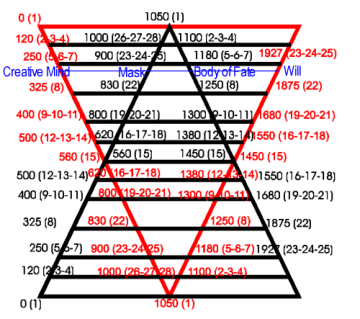
If a figure of two interpenetrating cones is used to represent the two-thousand cycle, then the respective starting points of the religious and civil cycles (0/1 and 1050 CE) will be at either end of the figure, which will span some one thousand years. This is the diagram which appears at the beginning of ‘Dove or Swan’ (AV B [266]). The diagram is complicated on several counts, some are minor inconveniences and others more far-reaching: the explanation occurs separately (AV B 256-57), so that it is not immediately obvious where to find it; the explanation refers to red and black ink, which were used in the original printings, but have since been abandoned by the publishers, making it harder to work out what is going on; even with the different colours, it is not the simplest of diagrams and has perhaps too many elements for an initial exposition; the Phase numbers given relate to a 1050-year cycle, but placed within the timeframe of the 2150-year cycle; finally, the Faculties are not distributed according to their normal configuration (see configurations), since the Instructors ‘adopted a system of cones not used elsewhere in this exposition’ (AV B 256), with Phase 1 at both the broad and the narrow ends of the cones. (For a consideration of some of these problems, see James Lovic Allen, ‘“The Red and the Black”’, Yeats Annual 3; click here for a scan of the page as it appeared in the original 1925 printing.) The diagram to the right here, shows the diagram from AV B [266] with the red and black as originally printed, and with the addition of another colour, blue, for the line showing the ‘four historical Faculties related to the present moment. May 1925.’ (Yeats’s use of the year 0 CE [0 A.D.] may be inaccurate, but helps to distinguish the Phase from the year.) 
It is best, though, to start as Yeats advises: ‘If one ignores the black numbers it is simple enough’, and the diagram on the left here shows only those numbers; this figure represents ‘the gyre of religion [black] expanding as that of secular life contracts [red], until at the eleventh century [1050] the movements are reversed’ (AV B 256). Will starts its movement on the left-hand side of the figure, progressing downwards until it reaches the apex of the gyre, then ascends the right-hand side, with Creative Mind on the other side of the red cone, mirroring the motion of Will, and Mask and Body of Fate on the black cone, also moving down and then up again (see AV B 256). Nonetheless, the diagram is atypical, since Will and Mask are shown as being at the same Phase as they progress along the cone, rather than the diametric opposites which they normally are. This is only possible if the two cones are complementary to one another, rather than in their normal reciprocal relationship (where more antithetical means less primary etc.). The nature of the anomaly is such that it is not immediately obvious, and Yeats himself does nothing to draw attention to it or to explain it explicitly, so that the following examination may appear rather convoluted and technical to those who are just getting to grips with the System, who should skip the following section and return to it later if they want. It is, indeed, quite possible to ignore the detail and still come to much the same conclusions in this case, since the ordinary double cone can be used to demonstrate most of the same ideas and is necessary for the more important ones (much as we have been doing up until this point). Yeats actually makes little direct use of this construction, and it is slightly regrettable that this should be one of the major diagrams of the book. The situation is clearer, perhaps, if the cones are unfolded so that time moves in a single direction. The diagram below gives the ‘unfolded’ version, rotated so that appears across the screen (the lines also represent individual Phases rather than triads here to make the passage of the respective Faculties clearer). The two Lunar Faculties have been extracted here, and they move forwards in time.
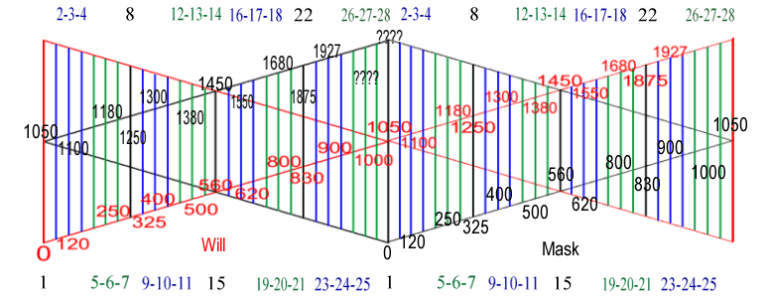
The red dates ascending from left to right follow the passage of historical Will through the Phases, and represent our conventional understanding of time, while Mask is located on the black cone. Will and Mask pass through exactly the same Phases in the same order in this representation, and they therefore cannot be connected directly since they are defined by their opposition. This opposition occurs instead in terms of date, with the same pairs of dates occuring in both halves of the figure, although it is immediately clear that there is a major disjuncture when Mask passes from the cycle’s end (2150?) to 0 CE. (The changing of ‘sides’ is mainly a product of the ‘unfolding’, since the folded version in A Vision shows it in this manner, and if one remembers that these represent spiral gyres, the apparent jump is not so radical.) The situation of the two Solar Faculties is possibly even stranger, since these two move backwards through the Phases (as is the norm) but also ‘backwards’ in time, and Body of Fate shows the same disjuncture as Mask. Since time is an illusion, there is, though, no real forwards or backwards. 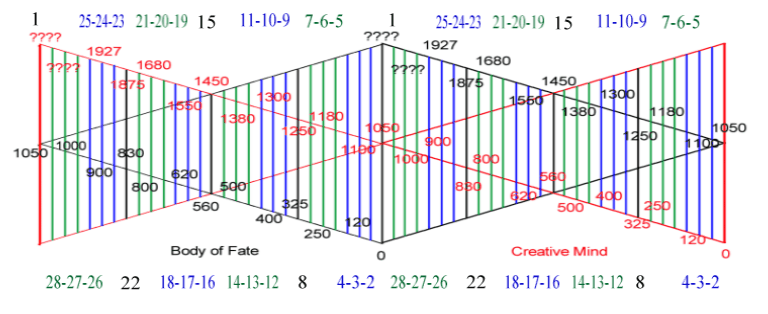
Yeats’s current date (1925) is located in both the Lunar and Solar figures towards the far right, so that Will is at 1925 on the threshold of Phase 23 (the Eleventh gyre starting in 1927), but Mask, also entering Phase 23, is at the very end of the ninth century (ca. 898?). Creative Mind is about to enter Phase 7 and is moving backwards towards the year 250 (ca. 252?), while Body of Fate, also approaching Phase 7, is moving backwards through the end of the twelfth century (ca. 1182?). These four periods are said to be ‘in Flinders Petrie’s sense of the word “contemporaneous”’ (AV B 256), periods which resonate with the present day. If we move towards our day (see below, Where are we now?), probably approaching Phase 26 and the Twelfth gyre, our contemporaneous periods are the Mask’s year 1000, the Creative Mind’s 120 and the Body of Fate’s 1100. What does this mean? These Faculties are ‘four interacting periods’ or ‘four periods of time eternally co-existent, four co-existent acts’ (AV B 256 & 257; this last description refers directly to a longer period than that under consideration here, but the idea still applies). At the end of a cycle, whether 1925 or now, the periods that are outside current reality are all in the past, and Yeats goes on to say that ‘as seen in time we explain their effect by saying that the spirits of the three periods that seem to us past are present among us, though unseen’; as a corollary, at the beginning of a cycle the contemporaneous periods are all in the future, so that there appears to be a form of undertow towards the future at the beginning of a cycle and one towards the past as the cycle draws to a close. Although all time is co-existent in some senses, these three corresponding periods impinge particularly immediately upon any given date. It is also partly because the epochs are sealed from each other in this way, referring towards their own future or past but not, within terms of this cycle, reaching to other epochs, that the next dispensation is unimaginable. 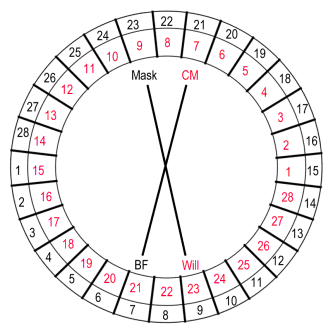 As important is the implication of the arrangement of the Faculties, since the disposition here points to the Faculties’ being placed in separate circles, which are at 180° to each other, so that Phase 15 on one wheel corresponds to Phase 1 on the other. In this way the Will and Mask are at the same Phase throughout the cycle, as are Creative Mind and Body of Fate. The attribution to dates in separate millennia (the two-thousand-year timeframe) in turn entails another level of doubling for each wheel (see left; the dates are the starting dates of the Twelve Gyres). In this representation the Faculties shift from one circle of the spiral to the other as the cycle progresses, either inwards (Creative Mind and Mask) or outwards (Will and Body of Fate). 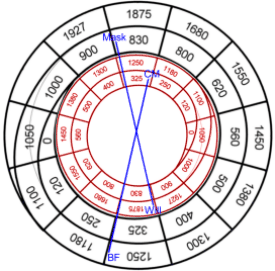
Yeats never draws such diagrams himself, so it is difficult to say whether he had explored these implications in such a way. He does, however, further symbolise the gyres in a form of conflict of the sexes, where those on the black wheel or cone, ‘Mask and Body of Fate are symbolic woman,’ and those on the red ‘Will and Creative Mind symbolic man’, together playing out a relationship of constant interchange and struggle. The relationship is not entirely normal however, and is compared to that between ‘the man and woman of Blake’s Mental Traveller’, where a male child grows up in the care of an old woman who grows younger, until they are the same age, he rapes her and leaves her. This man when old takes a young girl, and starts to grow young again while the girl ages, until he becomes a baby again, ‘The Babe! the Babe is born’ (cf. AV B 277) and is taken by an old woman, so that the cycle repeats itself. This strange, dream-like and violent world is based upon alternate ageing and juvenescence, and Yeats claims that the ‘student of A Vision will understand it at once’ (AV B 189n). Both the ‘male’ and ‘female’ gyre contain one forward moving component and one backward moving component. During the current, primary dispensation, ‘Mask and Body of Fate are religion, Will and Creative Mind secular life’ (AV B 256), and this will be transposed at the next annunciation or revelation. What is not clear is whether the attribution or experience of time will change in the antithetical dispensation. We are, after all, accustomed to the idea of dates ‘going backwards’, in the way that we number the period before the start of the Common Era, the birth of Christ as fixed by Dionysius Exiguus. These peoples never counted their own eras in this way and, similarly, the placing of dates backwards need not imply an experience of time running in reverse, but a shifting of reference towards a future point. However, in another sense Yeats does appear to posit a reversed flow of time. It seems implicit, but is not clear, that when Will and Creative Mind are transferred to the Solar cones of religion, that the emphasis will shift to Creative Mind so that the ‘male’ gyre will start to run backwards in time and rejuvenate, while in the ‘female’ gyre of Mask and Body of Fate, which will move onto the Lunar cones, the forwards-moving Mask will dominate. However, no details are given. Possible clues from the Automatic Script are that, ‘Throughout recorded history the value of time rose. But during subjective periods it fell again’, and, in one of the more far-fetched elements of the whole enterprise, that the mission of the Yeatses’ son was ‘to change the quality of the idea of time in men’s minds’(YVP 3 53). (There are also further links with the Daimon, which will be added to the site at a later date.)  ‘The Coronation of the Virgin’ (detail), 1453-54, by Enguerrand Quarton, Musée Pierre du Luxembourg, Villeneuve-lès-Avignon. Dove or SwanHistory is the province of the Faculties and, unlike in human life, all is incarnate life with no period between death and birth. All the same, the largest cycle that Yeats touches on, after the Year itself, is: ‘The wheel of the Four Principles completes its movement in four thousand years’ (AV B 263). As might be expected, the Principles are particularly concerned with the spiritual life, and in this four-thousand-year cycle, the alternate annunciations take place at the equivalents of the New Moon and Full Moon: ‘The life of Christ [as the start of our current era] corresponds to the mid-period between birth and death [the Full Moon]; A.D.1050 to death [Phase 22]; the approaching influx to the mid-point between death and birth [New Moon]’ (AV B 263). Effectively (and one has to be careful because of the alternative forms of Solar and Lunar Zodiacs and Phase wheels), the antithetical half of this 4000-year wheel of the Principles corresponds to the antithetical civilisation (in this case the classical one), and to human life, with the primary annunciation taking place at the Full Moon, the zenith of the antithetical tincture the primary civilisation, enabled by the Christian dispensation, starts at 1050, identified with death, and the antithetical annunciation will take place at the New Moon, the zenith of the primary. The Principles therefore provide part of the rationale behind the alternating dispensations, since their cycle lies behind the ‘influx’ of the particular revelation, although they only ‘inform the Faculties and it is the Faculties alone that are apparent in human history’ (AV B 207). In terms of the Faculties themselves ‘a religious dispensation begins and ends at Phase 15’ of the Lunar cycle of civilisation, the centre of which corresponds to the starting point of Aries in the Solar cycle of religion (Yeats is somewhat inconsistent but generally uses the Zodiac for Solar cycles and the Phases for Lunar cycles). However, the dispensations are not equal, since the ‘influx that dominates a primary dispensation comes a little after the start of the dispensation itself, at its Phase 16 perhaps, and that which dominates an antithetical dispensation a considerable time before the close of the preceding primary dispensation, its Phase 26 let us say’ (and this is where Yeats is inconsistent, meaning Phase 26 of the previous religious cycle, equivalent to 12 in the civilisation). The antithetical dispensation starts with revaluation in the midst of its predecessor rather than annunciation of its own new order, ‘it is, as it were, not so much a breaking out of new life as the vivification of old intellect’ (AV B 208), which Yeats symbolises in ‘Conjunctions’ as ‘a crop of mummy-wheat’, the germination of seeds stored centuries ago (see below). The relationship of the Solar and Lunar Wheels is rather tangled, particularly in the relationship of the Zodiac and the Phases with the different Faculties and Principles. When the Lunar Faculty (Will or Mask depending on the dispensation) is at Phase 16-17, the corresponding Solar Faculty is moving from Aries, ruled by Mars, into Taurus, ruled by Venus, a ‘primary revelation begins therefore under Mars-Venus’ (see Planetary Rulerships):
The Christian revelation entails violence, sacrifice and love, despite its peaceful message. In contrast, since Phase 12-13 corresponds to the Solar transition between Aquarius (traditionally ruled by Saturn) and Pisces (traditionally ruled by Jupiter), ‘an antithetical [revelation begins] under Saturn-Jupiter’:
The seed that has lain dormant for two millennia will germinate again, symbolising the vivification of the old intellect. In terms of the stories, this is also the third egg of Leda, ‘its miraculous life still unquenched’ (AV B 51) after four thousand years, which Robartes and Mary Bell will take to the desert to hatch. It is nothing new and yet entirely new, so that its influx ‘will arise after a long preparation and as it were out of the very heart of human knowledge, and seem when it comes no interruption but a climax’ (AV A 214). (See also the notes on ‘The Double Vision of Michael Robartes’.
Whatever its character, however, a revelation is alien, since an annunciation is the irruption of the divine world into the human, and in human terms irrational. The new dispensation is not the cause of the secular order’s decline, but its rise inevitably accompanies it. Within the smaller thousand-year version of civilisation, however, the revelation comes at the end of the cycle:
Yeats’s emphasis on the importance of the non-rational in Christianity predates the Automatic Writing, and he wrote in 1916 that ‘the Deity gives us, according to His promise, not His thoughts or convictions but His flesh and blood’ (E&I 235), and this emphasis was reinforced by the ideas of the System where all revelation is linked to the influx from without. Yeats sees the antithetical as expressed through the manifold forms of creation, in opposition to the primary, which looks to the abstract and unified. Phidias’s sculptures of the Olympian gods ‘put down / All Asiatic vague immensities’ (VP 610), but with Constantine’s conversion the ‘world became Christian, “that fabulous formless darkness”, as it seemed to a philosopher of the fourth century, blotted out “every beautiful thing”, not through the conversion of crowds or general change of opinion, or through any pressure from below, for civilisation was antithetical still, but by an act of power’ (AV B 278). Yeats repeats this phrase (attributed to the fourth-century Neoplatonist Antoninus by Eunapius) in his play The Resurrection, when he envisages the return of the primary which had held sway during the Babylonian era. He imagines the shock of Christ’s resurrection as its destruction of reason’s boundaries, and this includes the mythic thought of the Egyptian as much as the rational thought of the Greek. At the end of the play (1927, Adelphi version), the Egyptian expresses his horror:
There is no denial of the miracle or the validity of the Christian faith, but there is a context in which it is seen as a manifestation for a period rather than for all time. As the Christian revelation is no repetition of the Babylonian primary, so the new antithetical will be no repetition of the classical era. Nonetheless, Yeats has no other point of comparison for the revelation. When he tries to conceive of the possible nature of new he can do so only by analogy and reversal, so that the ‘rough beast’ of ‘The Second Coming’, which may be either the inhuman symbol of the revelation or the Sphinx that will challenge the new Oedipus, is seen as ‘Slouching towards Bethlehem’, not because it repeats Christ’s birth but because this is the birthplace of revelation par excellence, a succinct and evocative reference in a single word. Evidently there will also be similarities in the way in which the age prepares for its reversal, so that ‘When the new era comes bringing its stream of irrational force it will, as did Christianity, find its philosophy already impressed upon the minority who have, true to phase, turned away at the last gyre from the Physical Primary’ (AV A 213), just as some of the mysteries and philosophies of the ancient world looked away from the antithetical towards primary unity. More generally Yeats sees a form of ‘tribalism’ arising: ‘I imagine new races, as it were, seeking domination, a world resembling but for its immensity that of the Greek tribes—each with its own Daimon or ancestral hero—the brood of Leda, War and Love; history grown symbolic, the biography changed into myth’ (AV A 214) but expects ‘neither a “primitive state” nor a return to barbarism as primitivism and barbarism are normally understood’ (AV B 262). However, beyond this, though he can imagine these groups forming, ‘those kindreds once formed must obey irrational force and so create hitherto unknown experience, or that which is incredible’ (AV A 215). 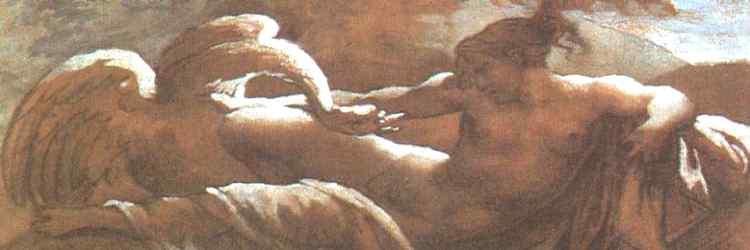 ‘Leda and the Swan’ (detail), by Theodore Géricault (1791-1824), Musée du Louvre. The FutureWhen he came to publish the second edition of A Vision, ‘Dove or Swan’ was repeated almost unchanged from the first edition. The major change that did occur was the excision of the final five pages dealing with the current period and the near future (text). These were replaced by two pages of far vaguer musings, ‘The End of the Cycle’. It is difficult to know exactly why, but part of the reason may be that Yeats did not see himself as a prophet, certainly not one with confidence. He complains that ‘it seems as if I should know all if I could but banish such memories [of other people’s predictions] and find everything in the symbol’, ‘But nothing comes—though this was the moment to reward me for all my toil. Perhaps I am too old’ (AV B 301). Another part of the problem is his increasing conviction that the very nature of the influx is irrational and not amenable even to the symbolic reasoning of his System, ‘Then I understand. I have already said all that can be said. The particulars are the work of the Thirteenth Cone or cycle which is in every man and called by every man his freedom’. The Thirteenth Cone, which stands for the divine in Yeats’s System, is referred to in language which recalls that of Jesus in the Little Apocalypse of Mark’s Gospel: ‘But of that day and that hour knoweth no man, no, not the angels which are in heaven, neither the Son, but the Father’ (Mark 13:32), and Yeats almost personifies his Cone: ‘Doubtless, for it can do all things and knows all things, it knows what it will do with its own freedom but it has kept the secret’ (AV B 302). It also is probably a consequence of having lived with the System for a while, and having seen whatever inklings that he may have had proved wrong by events that made Yeats uncertain of any predicition. In an unpublished piece, ‘Michael Robartes Foretells’ (Appendix B in Adams, Blake and Yeats), Yeats uses Robartes as a mouthpiece to express the problems of prophecy. It is written with the same cast of characters that appears in the Stories of Michael Robartes and his Friends, which first appeared with The Resurrection in a Cuala imprint of 1931 (and, in expanded form, in A Vision), so it seems to come from an intermediate stage between the first edition and second edition. Although the full text appears elsewhere on this site, it is worth noting Robartes’ comment that ‘When we speak of the past, we can say that in Divina Comedia, or the Russian Revolution, expressed such and such a phase, but are misled the moment we try to imagine some future work of art or historical event’. When he does hazard vague trends he also notes that ‘we have no means of fixing the date, nor will it be the same date everywhere’. Certainty and clarity with respect to the nature of the coming days might be easier for the reader to grasp, but it is the very nature of complexity that even with mathematical rules and simple consituents there is no way of telling the larger outcome. The terrible confidence that derives from a partial and simplistic view is not available to Robartes, let alone Yeats. Though realism and qualification are not normally expected of prophets, Yeats is not a prophet, and it is in the poems that the speculations reach their most vivid forms, since, in Philip Sidney’s terms, poetry cannot lie. Even ‘Old Rocky Face’, the Delphic Oracle, only has one word:
Where are we now?If we pigeon-hole Yeats’s theories as simply his private mania, as many do, there is no real point in asking where the gyres have come to: they served to inspire evocative and affective poetry. Even if we treat them as the fascinating product of an intelligent and creative couple, a system with a coherence and poetry of its own, there is not much more point in asking for the date of the new gyre. However, it is quite natural to wonder how far the gyres are meant to have progressed in our own time, without this being a prelude to a Yeatsian creed, and it is certainly a recurrent question. But it is far from easy. Since the movement of the gyres is not predictable, Yeats does not hazard any guess at the transition dates that lie before him, rejecting even the Instructor’s date of 2050 for the start of the twelfth gyre. If we decide to accept it, however, with Phase 23 fixed as starting in 1927, then we are probably currently, at the start of the twenty-first century, in Phase 24 and moving towards Phase 25, with Phase 26 starting in 2050. If we remember what poor predictors various Instructors were, concerning such different things as the end of the Great War (YVP 1 362-64) or Francis Stuart’s (1902-2000) supposedly short life (YVP 3 31), Yeats was quite probably right to jettison the date he was given. Another basis could be the likely lengths of period, given the shape of the whole scheme. The mean distance between two Phases of crisis (1, 8, 15, 22) should be around 270 years, but actually varies between 425 and 200 years; even looking at the transitions ‘contemporaneous’ with the end of the cycle, provides considerable variation, but does at least give some parameters. Looking at the passage of Will from 1875 to the undated end of the cycle, the ‘contemporaneous’ period is 325 years for Creative Mind (325–0), 220 years for Mask (830–1050) and 200 years for Body of Fate (1250–1050). This would place the end of the cycle somewhere between 2075 and 2200, with the start of the twelfth gyre between 1927 and the end date, probably between 2001 to 2065. Michael Robartes in his unwillingness to predict (see Michael Robartes Foretells), still sees that ‘the Dictatorships in various parts of the world, including the Russian, are the approach of the 24th. Phase’ and then speaks of how, as ‘Phase 25 draws near, in thirty or sixty years—we have no means of fixing the date, nor will it be the same date everywhere—men will turn from the leadership of men who offer nothing reason can understand’. Whether such a point has been reached is moot. Whatever the actual Phase, Yeats’s bias makes an antithetical religious period start well before the end of the cycle, Phase 26 of the 2150-year period, so that, in these terms, we are almost certainly in the antithetical period, or its penumbra, already. There is perhaps a natural tendency to want to bring the ‘interesting times’ closer to our own day, and by making the antithetical dispenstion longer than the primary, Yeats may even have brought it within reach of his own lifetime. Astrologers have argued over when the equinox shifts into Aquarius, whether the boundary is that of the conventional 30° sign of the Zodiac or the constellation, whether the influence starts before or after the transition, and therefore when the Age of Aquarius begins. Yeats and George Russell (AE) thought that they could discern it at the end of the nineteenth century, but reading the signs to fit a theory is open to wishful thinking and misinterpretation
| |||||||||||||||||||||||||||||||||||||||||||||||||||||||||||||||||||||||||||||||||||||||||||||||||||||||||||||||||||||||||||||||||||||||||||||||||||||||||||||||||||||||||||||||||||||||||||||||||||||||||||||||||||||||||||||||||||||||||||||||||||||||||||||||||||||||||||||||||||||||||||||||
The essay "W. B. Yeats's A Vision: 'Dove or Swan'," by Matthew DeForrest in the collection W. B. Yeats's "A Vision": Explications and Contexts, edited by Neil Mann, Matthew Gibson, and Claire Nally (Clemson University, 2012).
This title is available for free download here or here from Clemson University Press (click here if seems the link may have changed). It is also accessible online via Liverpool Scholarhip Online and University Press Scholarship Online (simplest to search on "Yeats" and "Vision"; direct link functional April 2016), though this is by subscription or through a library.
